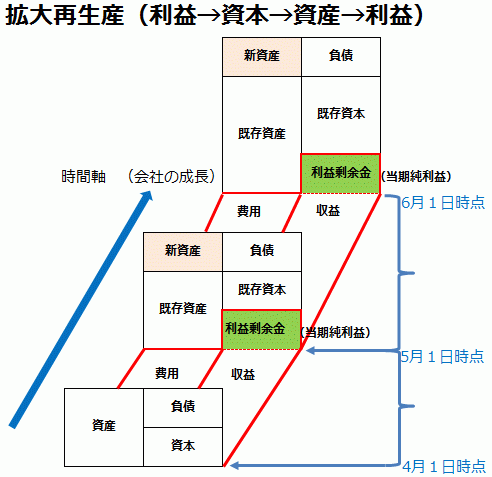The monthly profit under the Profit and Loss Method is calculated as "Revenue at the end of the month – Expenses at the end of the month," whereas the monthly profit under the Property Method is the increase in capital expressed as "(Assets at the beginning of the month – Liabilities at the beginning of the month) – (Assets at the end of the month – Liabilities at the end of the month)," and both methods yield the same amount. Accounting System in Indonesia The cloudification of accounting systems is advancing in Indonesia, with the three major local cloud systemsAccurate, Zahir, and Jurnalleading the market. However, in reality, it is said that fewer than 8% of domestic companies have implemented accounting systems. This is why new cloud-based accounting systems continue to be launched in what might seem like an already saturated Indonesian market. It suggests that both domestic and international IT startups see significant potential for cloud accounting systems to expand their market share locally. In Indonesia, automated journal entries due to the widespread use of accounting systems have become commonplace, and over the ... 続きを見る

The Difference Between Calculating Profit from Profit and Loss vs. Assets and Liabilities
When calculating the profit for a month, it is common to look at how much revenue (credit) exceeds expenses (debit) at the end of the month.
On the other hand, profit can also be considered as how much the difference between assets (debit) and liabilities (credit) has increased from the beginning to the end of the month.

Both methods result in the same figure, but essentially, it reflects how much capital (credit) has increased in a month. The amount of "Revenue at the end of the month – Expenses at the end of the month" represents the increase in capital, which is the profit for the month.
Calculating profit from profit and loss is called the Profit and Loss Method, while calculating it from assets and liabilities is called the Property Method.
The Profit and Loss Method allows profit to be calculated simply by aggregating the profit and loss accounts for the month. However, the Property Method requires aggregating the movements of assets and liabilities for the month while also needing the opening balances from the beginning of the month.
The balances of asset and liability (B/S) accounts at the end of the month are carried forward to the next month, but the profit and loss (P/L) account balances are not carried forward. Instead, they are transferred to the equity section of the B/S, balancing the total debits and credits of the P/L and B/S.
How to Aggregate Balances of Asset and Liability Accounts by Department at the End of the Month
Profit and loss accounts in the P/L typically have department codes assigned in the general ledger (G/L), allowing the monthly amounts to be aggregated by department at the end of the month.
On the other hand, asset and liability accounts in the B/S typically do not have department codes assigned in the G/L. The opening balances carried over from the previous month are not usually broken down by department, and even when department codes are assigned, they are often a representative department such as "company-wide" in most cases.
Therefore, to perform department-wise aggregation of assets and liabilities after the accounting system is operational, it is necessary to designate a cutoff point and create offsetting journal entries at the end of the month to reclassify the balances within the same account, with "debits by department and credits to a representative department."
- (Debit) Cash/Bank (Department Code A) 10 (Credit) Cash/Bank (No Department Code) 30
- (Debit) Cash/Bank (Department Code B) 10
- (Debit) Cash/Bank (Department Code C) 10
This enables the aggregation of asset and liability accounts by department code in the G/L starting from the following month.
Revenue and Expense Approach
In the previous discussion, we overviewed the relationship between internal controls required by JSOX and IT compliance. This time, we will examine another distinct trend apart from JSOX: IFRS and system responses. Paying attention to both JSOX and IFRS has become an inevitable trend in system implementation.
Japanese accounting standards emphasize the P/L (Profit and Loss Statement), stemming from the high-growth era's upward-trending economy, where future predictions could easily be made based solely on the current period’s profit and loss. In essence, the approach involves preparing the P/L first and then supplementarily recording the assets, liabilities, and equity items—sources of future revenue and expenses—in the B/S (Balance Sheet). Rather than verifying and re-evaluating B/S items to reflect reality, there is a strong tendency to use tax law valuations directly as accounting valuations, processing them as extraordinary gains or losses when depreciation is complete.
Asset and Liability Approach
In contrast, IFRS accounting standards aim to provide investors and creditors with the information necessary to evaluate enterprise value. To achieve this, it emphasizes the B/S by re-evaluating fixed assets for impairment, valuing marketable financial assets at fair value, and accurately preparing the B/S to show whether the asset situation can generate future cash flows. While consolidated financial reporting must comply with IFRS, tax reporting still requires preparation based on each country’s unique standards.
What Does IFRS Compliance Mean for Systems?
There are two cases: addressing it through system modifications or operational changes. The matters we generally propose to clients during system implementation are as follows:
- Revenue Recognition on a Realization Basis
If revenue is recognized on a shipment basis (accrual basis), it is better to issue an invoice at the time of customer acceptance, recording A/R and revenue accordingly. - Uniform Inventory Valuation Method
Since inventory valuation methods need to be unified across consolidated companies, it is preferable to align with the Japanese head office’s method. IFRS allows FIFO, moving average, standard cost (standard unit price), and weighted average methods, but LIFO is not permitted. - Separate Management of Physical and Accounting Inventory
In most cases, the cost of goods sold is finalized through an end-of-month physical inventory count. However, mid-month inventory and accounting mismatches are managed as assets for unrealized sales using subsidiary ledgers. - Re-evaluation of Tangible Fixed Assets
Instead of adopting tax law standards for accounting purposes, tangible fixed assets should be re-evaluated each fiscal year, reviewing depreciation methods and useful lives. - Cash Flow Statement (Direct Method)
In Indonesia, cash flow statements are not mandatory and often not prepared, but they become nominally required. - Multi-Standard Ledger
While tax reporting can remain based on each country’s unique standards, consolidated financial statements must comply with IFRS (B/S emphasis). Accounting is obligated to comply with IFRS for investors and creditors, but tax authorities may not necessarily accommodate this. Ideally, accounting systems should implement a multi-standard ledger function, managing accounting entry data separately and allowing optional aggregation during output.



